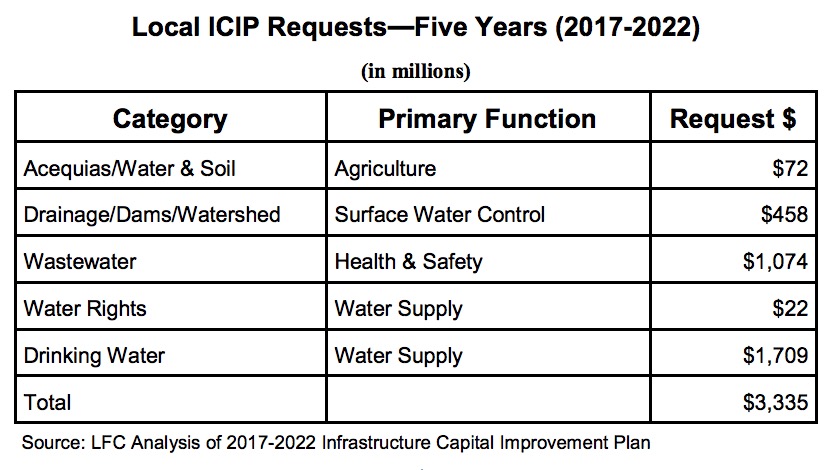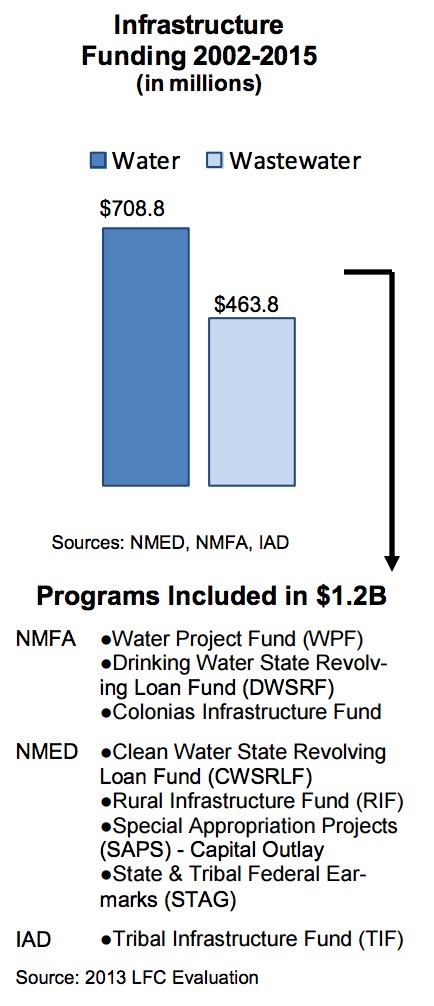NEW MEXICO LEGISLATIVE FINANCE COMMITTEE
Improved Processes Still Lack Coordinated Approach
 Water, along with adequate roads and a skilled workforce, set the bar for economic growth. A deficiency in any of these three key factors lowers the state’s ability to attract, retain, and grow businesses and jobs for advancing citizen welfare. By itself, investment in water infrastructure would add 36 thousand jobs each year for 20 years in New Mexico, according to the National Association of Water Companies. But funding is in decline to support such an aggressive investment plan.
Water, along with adequate roads and a skilled workforce, set the bar for economic growth. A deficiency in any of these three key factors lowers the state’s ability to attract, retain, and grow businesses and jobs for advancing citizen welfare. By itself, investment in water infrastructure would add 36 thousand jobs each year for 20 years in New Mexico, according to the National Association of Water Companies. But funding is in decline to support such an aggressive investment plan.
Building on criteria established for expending public funds prompted by House Joint Memorial 86 (2005), the Water Trust Board process supports projects that are fully funded and ready to proceed. Coordination among the various funding agencies has improved through the Water Infrastructure Team initiated in 2014 but remains in its infancy. Fragmentation of funding programs persists, and lack of planning or requirements for capital outlay requests can leave projects sidelined due to incomplete funding or project readiness. Most notable, $66 million, or 79 percent, of 2014 “Year of Water” appropriations were sitting unexpended as of April 2016.
Despite allocating $1 billion since 2002 to improve water infrastructure, local area needs reportedly run from $1 billion to $3 billion. The New Mexico Environment Department has not released recent survey results that would pinpoint accuracy to inform policy direction. Additionally, legislation would be required to implement a centralized process to effectively prioritize limited funding statewide.
State Has Spent $1 Billion Yet Faces Unknown Investment Needs
 The state has not fully reported local water project needs and estimates vary. The 2013 EPA Drinking Water Survey calculated New Mexico’s 20 year drinking water needs at $1.3 billion, and an earlier 2008 Clean Watersheds Needs Survey pegged wastewater infrastructure costs at an additional $103 million. In 2014 a New Mexico multi-agency task force tallied 652 current “local needs” projects totaling almost $700 million. However, several projects were not quantified and a final document was not distributed as a precursor to the 2015 legislative session to help guide dollars toward progressing or completing projects funded in the 2014 “Year of Water.” Likewise, the New Mexico Environment Department (NMED) did not release the 2015 survey results for the 2016 session.
The state has not fully reported local water project needs and estimates vary. The 2013 EPA Drinking Water Survey calculated New Mexico’s 20 year drinking water needs at $1.3 billion, and an earlier 2008 Clean Watersheds Needs Survey pegged wastewater infrastructure costs at an additional $103 million. In 2014 a New Mexico multi-agency task force tallied 652 current “local needs” projects totaling almost $700 million. However, several projects were not quantified and a final document was not distributed as a precursor to the 2015 legislative session to help guide dollars toward progressing or completing projects funded in the 2014 “Year of Water.” Likewise, the New Mexico Environment Department (NMED) did not release the 2015 survey results for the 2016 session.
Using the 2017-2022 local infrastructure capital improvement plan (ICIP) as a proxy, the total water-related requests made by local entities, including tribal; county; acequia; town, village or city; soil & water conservation district; and mutual water association topped $3 billion. Local entities are not required to submit an ICIP so the final tally might be higher. Other considerations might lower the number, such as over-estimating project costs due to the lack of a preliminary engineering report that would more accurately portray values.
State needs added another $200 million. State agencies are required to submit capital outlay requests during the annual ICIP process. Thirteen projects distinguishable as water-related totaled $113 million, submitted by four agencies. In addition to its ICIP requests, the Office of the State Engineer published its annual list of New Mexico dams with the most pressing need for rehabilitation at an estimated cost of over $120 million.
As detailed in Appendix A, since 2002 the state has directed over $1 billion toward remedying drinking water and wastewater infrastructure issues. New Environmental Protection Agency (EPA) guidelines for arsenic in drinking water, for example, prompted investment in new technologies to meet the revised standards. Other projects replaced aging water or sewer lines, extended them to new areas, or added reuse options for increasing water inventories.
The funding covers over 2,000 projects (or phases of projects) under eight dedicated programs administered by NMED, the New Mexico Finance Authority (NMFA), and the Indian Affairs Department (IAD) during this period. As noted in Appendix B, the total only includes the major water and wastewater infrastructure programs as presented in the original 2013 LFC evaluation. For example, water-related projects funded through NMFA’s acequia project fund, the local government planning fund, and the public project revolving fund are excluded as well as other state, federal, or private programs.
Download full version (PDF): Water Project Dollars Slow to Spend
About the New Mexico Legislative Finance Committee
nmlegis.gov/Entity/LFC/
The mission of the Legislative Finance Committee is to provide the Legislature with objective fiscal and public policy analyses, recommendations and oversight of state agencies to improve performance and ensure accountability through the effective allocation of resources for the benefit of all New Mexicans.
Tags: LFC, New Mexico, New Mexico Legislative Finance Committee, NM, NMED






 RSS Feed
RSS Feed